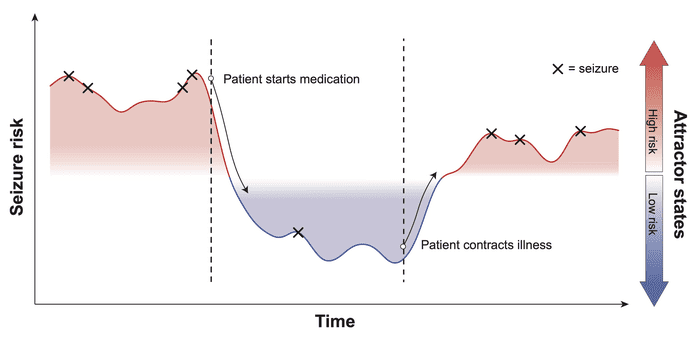One in 26 people in the United States will develop epilepsy at some point in their lives and that list is growing with 150,000 new cases of the disease reported every year. An estimated 3.4 million Americans and 65 million people worldwide currently live with epilepsy.
The condition impacts people of all ages and races. It can result from a number of underlying conditions, such as head trauma, or occasionally a person may simply be a victim of hereditary coincidence. Sometimes there is absolutely no explanation for it.
For many who suffer from epilepsy, seizures occur like clockwork. However, everyone has a different clock and while seizures can be triggered by many events, why different patients experience different seizure cycles is unknown.
In order to give people with epilepsy a better understanding of how and why their seizures occur and perhaps to better recognize the early warnings, a new study led by researchers from Rice University and the University of California, San Francisco (UCSF), published in the Proceedings of the National Academy of Sciences, sought to formalize how, exactly, those clocks tick.
“We developed a new statistical model to explicitly capture the effect of factors that may drive transitions in seizure risk,” said Rice alumna Sharon Chiang, a clinical instructor and research fellow at UCSF. “We looked at anti-seizure medications and different triggers like illness and menstrual cycles. Those are some of the factors commonly thought to increase or decrease seizure risk.”
The relationship between cycle length and age was an interesting finding. Chiang and her cohorts discovered that there were shorter cycles in older age groups and longer cycles in younger epileptics.
“A shortening of cycle length with age may have potential ramifications in future clinical practice,” she said.
In 2019, researchers from Rice analyzed patients’ seizure diaries to assess their seizure risks and looked at brain scans to discover markers for patients with epilepsy most likely to benefit from brain surgery.
The year prior, researchers from UCSF completed a similar study to the new paper where they discovered monthly cycles of brain activity in epilepsy patients that were linked to seizures. That finding suggested that clinicians could soon be able to predict when patients are most likely to have seizures, allowing patients to plan around these brief but potentially dangerous events.
The new work aims to emphasize the importance of logging seizures on a daily and long-term basis. This will aid in the establishment of individual chronotypes, or rhythms, for patients who have seizures in cycles and want to understand why they happen when they do, what may trigger them, and how to best treat them.
An online seizure diary simplifies the process for patients while also providing the researchers with a wealth of data to mine for their statistical dynamical systems models, with the “dynamic” part capturing change over time. Co-author Robert Moss founded Seizure Tracker, which provides tools to help patients, doctors and researchers understand the relationships between seizure activity and therapies that will improve patient care.
The logs of over 1,000 patients, ranging in age from two months to 80 years, were used to help the team model the relationship between “attractor states,” internal and/or external events such as the start of a new medication or illness, and the peaks and valleys of seizure activity in an individual patient for the current study.
“The purpose of this model is to try to guide the patient and the doctor, in particular,” said Marina Vannucci, the Noah Harding Professor of Statistics at Rice’s George R. Brown School of Engineering. “We want to help doctors say, ‘OK, this medication is really important for this patient with this type of seizure,’ and control their seizures in a better way…Calm stretches between seizures seem to get shorter for patients as they get older. Triggers and age are the two factors we found to be significant for the change of attractor states. The data shows that with age, patients have shorter cycles. It seems like an obvious thing, but the link had not been formally established.”
Vannucci said the new study is the product of research that began in 2017 where doctors and their patients sat down to discuss the frequency of their seizures. Were they going up, down or remained the same?
Those discussions resulted in a 2018 Epilepsia Open study that suggested a Bayesian model could better define seizure risks for patients. From there, Vannucci said the team incorporated attractors and other covariates like medications to build the model detailed in the current study.
“We hope this study is the best of all and the most helpful for patients and doctors.”



